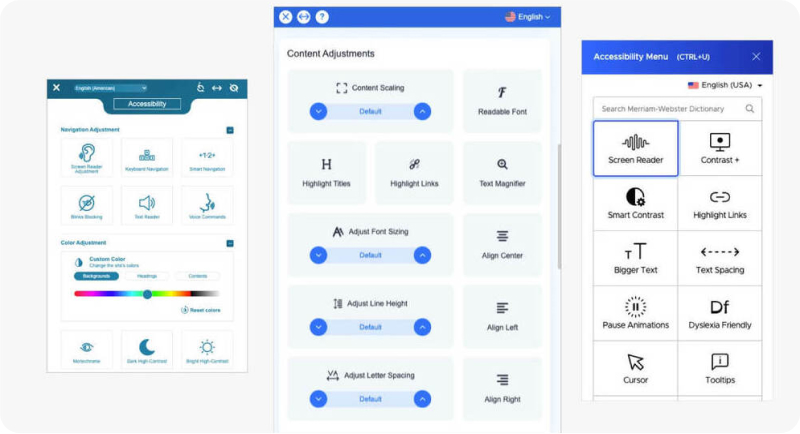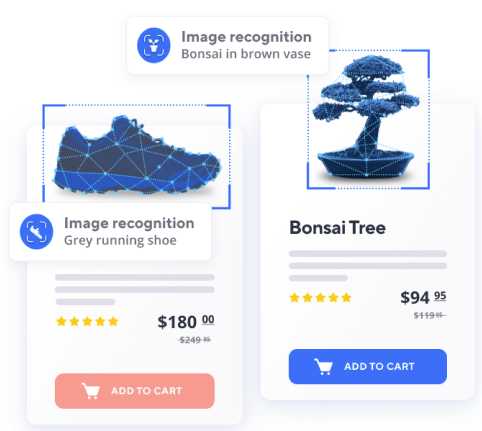In today’s digital world, making your website accessible is not only a social responsibility but also a compliance issue that many site owners and businesses are rapidly adopting.
Website ADA-related lawsuits have risen by 300% year over year, and are expected to increase even more.
The exponential growth in web accessibility lawsuits has a widespread effect across industries, with small and medium businesses in the center of the storm.
By making your website accessible and ADA compliant, you’ll protect yourself from legal risks, boost your brand’s reputation, and expand the browsing capability of your website to a wider audience.

Not all plugins ensure compliance with the ADA
When it comes to digital accessibility, there are no shortcuts. Compliance is a living, breathing piece of your overall website and strategy. It is not something you can tack on half-heartedly. Many site owners turn to free website plugins to implement certain accessibility functions on their website, but the truth is, these usually do not result in a fully compliant site and will put your business in legal risk.
Keep reading to learn more.
How to make your website fully compliant?
To ensure full compliance with the ADA for websites, the accessibility plugin needs to include two main functionalities:
- An accessibility interface
- Map website elements for assistive technology compatibility (screen readers and keyword navigation tools used by disabled users)
Let’s take a closer look..
What is an accessibility interface?
An accessibility interface will allow any visitor to adjust the website’s design and user interface elements to fit their individual needs or disability. Example use cases of an accessibility interface include:
- ADHD friendly profile – Reduces distractions, allows individuals with neurodevelopmental disorders to ingest website content more easily
- Visually impaired profile – Allows for larger text, contrast, and careful use of colors
- Keyboard navigation profile – Assists the motor-impaired by allowing keyboard shortcuts
- Cognitive disability profile – Helps users with cognitive disabilities like Autism and dyslexia, to focus and understand important website elements
Here are some examples of accessibility interfaces:

* You can check the accessibility interface we use in the bottom right corner of the website
What are assistive technologies and how to become compatible?
Screen Readers
Allowing for screen readers to function on your website is a crucial component of digital accessibility. A screen reader is a device used by visually impaired users. It will usually begin at the top of a website and read the content- which includes both texts and alternative text for images. For someone with a vision impairment, a screen reader allows them to understand what is on your website, gain access to your information and services, and equally and fully use your site as other users can.
Frequently, images on your website tell part of the story you are trying to convey to users. Some images might explain places, things, display your product or otherwise contribute to the overall contextualization and understanding of your website content. Any graphic content or imagery added to your website needs to use alternative attributes or alt tags. These tags contribute invaluable information to visually impaired readers and help them comprehensively understand the site. Without alt tags, the experience of your website can be incomplete and downright frustrating.
For example:
When a button does not have an accessible name, screen readers and other assistive technologies announce it as “button”, which provides no information to users about what the button does.

Navigation Tools
Not every user who comes to your website will have a full motor function. Those with a motor disability deserve equal access to navigating the internet, including your website. Certain navigational tools can be implemented to allow for ease of movement. These include:
- Using specific keyboard keys like Tab, Shift+Tab, and the Enter keys for specific purposes on the website
- On-screen keyboard availability for individuals unable to use a computer mouse
- Shortcuts such as “M” (menus), “H” (headings), “F” (forms), “B” (buttons), and “G” (graphics) allow users to more quickly and easily access specific elements of your website
- Faster navigation techniques that allow users to access any important page with a click
Website accessibility 2.0
In the past, companies resorted to a manual approach to updating and amending their websites to be more accessible and compliant. A manual method can be costly, as it requires a specialized professional to audit, plan, and implement the changes.
Fully Manual methods are now generally considered outdated, as semi-automated solutions have impacted how easily companies can update their websites.
Companies like acessiBe have completely transformed the landscape of automated solutions for digital accessibility. acessiBe’s artificial intelligence (AI) scans and analyzes websites using contextual understanding and image recognition to learn what elements and functionality they include.
From there, the platform can adjust various elements to identify compliance issues. acessiBe will automatically evaluate alt tags, forms, icons, buttons, controls, and more.
Thankfully with automation has come a lower price tag. An all-in-one solution from accessiBe offers daily audits, auto-tagging, legal litigation support, and an accessible interface.
Are you worried that semi-automated solutions will affect your website’s code?
Well, you can rest easy. Automated solutions don’t change the website’s code, and therefore they can’t affect SEO. These solutions merely change the front end that’s loaded on the user’s browsers. Your hard work and resources invested in SEO efforts are not endangered.

Web accessibility plugin rankings
We’ve analyzed the top service providers for website accessibility compliance and ranked them (relative to each other). The score is based on the following methodology:
50%
WCAG & ADA Compliance Level
5%
Ease of installation
25%
Price range
5%
Turnover time
10%
Platform Compatibility
5%
Support
Comparison of top ADA solutions
Starts at
$49/monthStarts at
$49/monthStarts at
$49/monthStarts at
$49/monthStarts at
- 1 Free License 20% discounts/Payouts No commitment fees
- Fermentum at et mauris Integer nisl massa, rhoncus Sed quis eu, pharetra
- Fermentum at et mauris Integer nisl massa, rhoncus Sed quis eu, pharetra
- Erat vulputate ultrs integer Urna turpis habitasse Sagittis feugiat sodales
Yes
Includes a free website accessibillity audit
Yes
Includes a free website accessibillity audit
Yes
Includes a free website accessibillity audit
30 days free trial
No credit card needed
30 days free trial
No credit card needed
30 days free trial
No credit card needed
A closer look at each solution
1. AudioEye
Pros
Cons
Existing Clients
2. UserWay
Pros
Cons
Existing Clients
3. Level Access
Pros
Cons
Existing Clients
What’s next for your website?
Now one question remains about website accessibility and compliance: Where does your business stand? Thanks to technological advancements and automated solutions, achieving website compliance has never been easier.
We strongly recommend taking advantage of accessiBe’s special offer for a 7-day free trial (no credit card required) which will help you get a better understanding of their product.
Why should you act today?
Thankfully, your business’s compliance journey will not only protect you legally, but open your business to an entirely new world of users, innovative practices, opportunities, and more.
When your business views compliance as a friend instead of a foe, it opens up a world of digital innovation, automated solutions, and improved business processes.
We’ve compiled 4 important tips that will help you to understand why website accessibility should be a top priority for your business.
Opportunity to Extend Market Reach
First and foremost, making your website accessible and compliant ensures you reach a wider audience. In fact, the global market of individuals with disabilities spans over 1 billion people, or 20% of the population. When your website is not compliant, you lose users who cannot navigate it due to hearing, visual, motor, or other limitations.
It’s a Legal Issue
Meeting compliance requirements is not only important to extend your market reach, but it’s also a legal matter. In recent years, lawsuits regarding website compliance have skyrocketed with a 152% increase in lawsuits over the last five years. Major corporations like Winn Dixie and Domino’s have gone through high profile court battles over their website accessibility.
With the increase of awareness surrounding compliance, small and medium-sized businesses are also receiving a record number of demand letters and lawsuits. Legal proceedings take away precious time and resources from running your business and can end up costing you a significant amount of money in the long run.
Compliance Affects SEO
When you follow accessibility best practices for your website, you are actively optimizing your site’s SEO. Many site owners are sorely mistaken in thinking that accessibility compliance standards interfere with search engine optimization tactics and harm SEO professionals from performing their job at the highest levels. The truth is, SEO and website accessibility go hand in hand.
Google favors accessible websites and ranks compliant sites better in organic searches. These websites will feature accessibility standards in their content, design, and metadata. Google crawlers scour websites to index them, which ultimately affects your ranking in a Google search. Just like a person with a hearing or visual impairment, Google crawlers only use a keyboard (as they cannot “see” or “hear”). When your website is compliant, crawlers can navigate it more easily.
Inclusivity Matters
Site owners must internalize the concept that the web is a place for everyone. As our world becomes increasingly remote and dependent on the internet, the idea of what defines a public space is evolving. When people can purchase items, order, learn, and otherwise interact with your website, you are dealing with a new kind of public accommodation.
